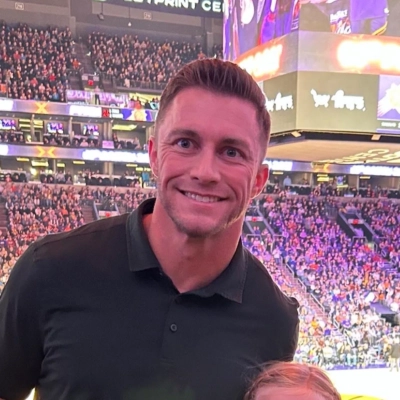25 Tech Trends Driving Economic Growth and Innovation
Discover 25 essential tech trends that are reshaping economic landscapes and driving innovation across industries, featuring expert insights from leading professionals. These strategies range from building referral partnerships to maintaining year-round customer engagement, all designed to create sustainable growth and deeper market connections. Each trend offers practical approaches to modern business challenges, with a focus on authentic relationships, clear messaging, and delivering genuine value.
Build Strategic Referral Partnerships for Qualified Leads
One of the most valuable lessons I've learned about customer acquisition is the power of strategic referral partnerships. We developed a network with complementary B2B IT companies where we refer leads that aren't ideal fits for our business but might be perfect for our partners, and they do the same for us. This approach has transformed our marketing strategy from cold outreach to receiving warm, pre-qualified leads, significantly improving our conversion rates and reducing the sales cycle length. In the B2B world, where sales cycles are longer, more complex, and face stiffer competition, strategic referrals can be the make-or-break deciding factor for prospects weighing their partner selection.

Free Tools Attract Better Customers Than Ads
We learned that our lowest-cost customers came from creating genuinely useful free tools, not ads. We built a free website speed checker that attracted 2,000 small business owners monthly, with 12% converting to paid services. The tool positioned us as helpful experts rather than pushy salespeople. Giving away real value first created trust that no amount of ad spending could buy.
Authentic Content Builds Deeper Customer Relationships
Early in our B2B marketing efforts, I made the critical mistake of focusing too heavily on branded messaging rather than fostering personal connections with potential customers. We learned that authentic content highlighting client success stories, industry expertise, and employee voices creates far more meaningful relationships with prospects than polished corporate messaging alone. This insight fundamentally changed our approach to customer acquisition, leading us to prioritize genuine storytelling and transparent communication across all marketing channels. The results validated that building trust through authenticity significantly improves conversion rates compared to traditional promotional tactics.
Under-Promise and Over-Deliver for Sustainable Growth
One of the most valuable lessons I've learned about customer acquisition is the importance of under-promise and over-deliver. Setting realistic expectations and then exceeding them builds trust and credibility, which is crucial for attracting and retaining customers. This mindset has shaped our marketing and sales strategies by encouraging us to focus on delivering tangible value rather than making bold claims. It also helps prioritize quality interactions over quantity, ensuring that every touchpoint reinforces reliability and professionalism. By consistently exceeding expectations, we've been able to turn early customers into advocates, create stronger word-of-mouth referrals, and establish a foundation for sustainable growth that supports long-term success.

Disqualify Bad-Fit Leads to Accelerate Growth
Quality Over Quantity in Prospecting
One of the most valuable lessons I've learned in customer acquisition is that saying "no" quickly to a bad-fit customer is one of the fastest ways to grow. When you're running a startup, there's a natural urge to chase every dollar and every lead that comes in, but we realized early on that low-fit clients with high demands and small budgets actually drain more resources than they provide. Time spent managing a difficult, unprofitable relationship is time taken away from serving your best, most profitable customers, or pursuing high-value prospects.
This knowledge has completely shifted how we approach our marketing and sales strategies. For marketing, we now focus obsessively on defining our ideal customer profile and creating targeted content that speaks directly to their complex pain points, thereby self-qualifying leads before they even reach our funnel. In addition to this, our sales team is empowered to actively disqualify leads that don't align with our ideal customer criteria—things like budget, organizational needs, and industry fit—within the first few days. That disciplined focus ensures our sales reps are only spending their time and expertise on opportunities that are genuinely likely to convert into long-term, high-value partnerships.

Give Value First Before Expecting Returns
Whether you are B2B or B2C every business is P2P and connecting on a personal level is what matters most. Successful businesses understand their product or service is about more than the transaction, they are in the relationship business. People buy brands they know, like and trust. One of the most valuable lessons I've learned about customer acquisition is the importance of giving value first before expecting anything in return. We've found success by offering potential clients helpful resources like articles, white papers, and webinars that address their pain points, which establishes our expertise and builds trust. This approach, coupled with active listening to understand client needs before attempting to sell, has transformed our marketing and sales strategy from transaction-focused to relationship-focused. Our teams now prioritize understanding the customer's business challenges first, which has significantly improved our conversion rates and client retention.
For me CRM is about the relationship so show that you value them and want to build a relationship beyond the transaction. It goes a long way when you take the time to educate, entertain and inform your audience, respect their time and show you care. Become a brand they can count on by having consistent communications, being transparent and delivering on the promises you make. When you share what you know, your passion/war stories/good/bad/ugly, the stories are interesting and the lessons real, people remember and come back for more. Tell your origin story, share mistakes/failures, be vulnerable if you want to drive engagement/build connections/relationships/trust with your audience just show your humanity which helps stand out versus generic AI content!

Clarity Beats Creativity in Customer Messaging
One valuable lesson I've learned about customer acquisition is that clarity beats creativity every time. Early on, I poured effort into clever campaigns and polished visuals, but they didn't convert because the messaging wasn't direct enough. Once I shifted focus to clearly communicating the problem we solved—and used real customer language instead of marketing jargon—everything changed.
I started conducting short interviews with existing users, pulling phrases directly from how they described our value. Those insights shaped our ads, landing pages, and sales scripts. The results were immediate: conversion rates doubled, and customer referrals increased because our message finally resonated.
That experience taught me that acquisition isn't about selling harder—it's about understanding deeper. Now, every campaign starts with listening. I build strategies around empathy and clarity, ensuring our message connects before we ever ask for a commitment. It's made our growth far more sustainable and authentic.

Align Marketing and Product Around Customer Journey
One valuable lesson is that acquisition only works when marketing and product speak the same language. In the early days, we treated them as separate functions. Once we aligned our messaging, features, and campaigns around the same customer journey, everything clicked. Leads came in warmer, activation improved, and our conversion path shortened. Consistency across the funnel turned into our biggest growth lever.
Brand Awareness Reduces Acquisition Costs
Investing in brand awareness is vital for early stage growth and ultimately reduces cost of acquisition over time. Even though top of funnel marketing activities take time to impact sales, are harder to track and measure, and often don't result in a direct sale, we've found that by ensuring we're always attracting net new leads, we're able to close the most lucrative deals faster and more efficiently. Knowing this, our brand marketing spend is a consistent in our budget and we are always testing new marketing strategies that drive awareness of our services.
Make Complex Value Clear Through UI
One of the biggest lessons I've learned is how challenging it can be to convey the full potential of a complex platform like Zors to users who haven't yet experienced it through a personalized demo.
Zors does a lot — from territory mapping and compliance tracking to franchise CRM and document automation — and while that range of functionality is what makes it powerful, it also creates a unique communication challenge. When a prospect skips the demo, we may not get the opportunity to explain the significance of a feature, how to use it, or even that it exists in the first place. That's the hardest part of customer acquisition: helping users grasp how transformative the system can be when so much of its value depends on context and workflow integration.
As we've added more moving parts, we've learned that the UI is everything. Every label, navigation path, and visual cue has to do some of the explaining for us. We're constantly refining menus, onboarding flows, and feature placement to make things obvious — because we might not get another chance to show someone what they're missing.
This realization has shaped both our product and our marketing. On the marketing side, we focus more on showing, not just telling — through short video demos, walkthroughs, and GIFs that highlight key workflows. On the product side, we treat user feedback as our north star, especially around navigation, labeling, and discoverability. Every time we make something easier to find or understand, we're not just improving the software — we're lowering the barrier for adoption.
In short, the biggest takeaway has been that clarity is conversion. When users can intuitively understand what Zors can do for them — even before talking to us — acquisition gets a whole lot easier.

Meet Customers Where They Already Are
One lesson that has shaped how I approach customer acquisition is to meet people where they already are. Convenience and trust drive action more than any campaign can. When we started placing our kiosks in familiar retail locations, usage increased immediately because people already felt comfortable in those spaces.
We didn't need to push harder on messaging. We needed to make the experience seamless and familiar. Every step, from the moment a person walks up to completing the transaction, had to feel quick, safe, and worthwhile. That mindset continues to guide how we design outreach and partnerships. It reminds me that growth happens when you make doing the right thing the easiest option.
Speed Beats Scale in Marketing Tests
The biggest lesson I've learned about customer acquisition is that speed beats scale every time. Early on, I spread budgets across too many channels and learned almost nothing. So I started tightening feedback loops, and CAC dropped about 25 percent. Running small tests, tweaking ad copy, and adjusting landing pages fast showed what actually converted. Because of that, results got more predictable and wasted spend went down.
Now I run campaigns in short cycles. Each sprint tests one thing, like a headline, targeting, or offer. When something works, I double down. When it doesn't, I move on quickly. This rhythm keeps data clean and spend efficient. The faster I learn, the smarter the next round gets.
It also changed how marketing and sales work. Faster insights help sales adjust how they handle new leads, while marketing fine tunes messaging based on what closes. So everything stays aligned, and deal cycles are shorter. I've learned to focus on learning fast so I can attract the right people before the budget runs dry.
-- Josiah Roche, Fractional CMO, JRR Marketing
https://josiahroche.co/ | https://www.linkedin.com/in/josiahroche

Show Real Benefits Instead of Technical Features
The fundamental lesson reveals that product features alone do not guarantee sales success. Our team dedicated initial efforts to build a robust backend system with scalable architecture yet we failed to confirm whether these technical capabilities solved actual customer needs. Our approach to product development transformed after we started conducting prospect interviews to learn about their current problem-solving methods which enabled us to create demo flows and sales decks that demonstrated real-world usage.
Our marketing approach and sales methods underwent a complete transformation. Our sales approach now begins with demonstrating the benefits our solutions deliver to customers instead of presenting technical frameworks such as .NET Core or Angular. The demonstration of our scheduling module reducing enterprise processing time by 40% proves more effective than showing technical specifications. The organization now focuses on delivering better work solutions to customers instead of concentrating on what they can create.

Optimize the First Thirty Seconds
One valuable lesson we've learned about customer acquisition is the importance of understanding and optimizing the user's first experience — what happens in the first 30 seconds after they discover or download your product.
We invested early days on prioritizing ads and targeting, the notion that more reach should necessarily equal more growth. But we realized that even great ads can't save an unclear onboarding flow or bad first impression. After we were obsessed with that first experience — from messaging consistency in ads to landing page simplicity and in-app guidance — our conversion and retention rates increased tenfold.
This lesson changed the way we approached:
- Marketing: We then craft ad creatives that are in complete alignment with the in-app experience such that the user immediately perceives the value to be received.
- Sales and Growth: Instead of going for pure volume, we target cohorts with highest engagement and build referral and retention loops around them.

Deliver What Your Product Actually Claims
I've learned that the most important thing above all else is offering customers a product that actually offers what it claims to offer. Even the most strategic, attractive marketing measures will fall flat if customers quickly learn that the product is sub-par. Customer acquisition isn't just securing that first sale but maintaining low turnover rates. This has led us to make sure that our strategies are transparent and truthful, always.

Acquire Community Trust Before Customer Signatures
The most valuable lesson I learned about customer acquisition for my startup is that you must acquire the community's structural trust before you acquire the customer's signature.
When I started, I chased every digital ad and cold lead, assuming volume was the key to acquisition. That was a hands-on mistake. The problem was that these clients were transient and only loyal to the lowest price, creating a financially unstable structure for the business.
This knowledge fundamentally influenced my marketing and sales strategies. I stopped spending money on broad advertising that targets abstract demographics. I shifted my entire acquisition strategy to focus on generating hands-on, high-integrity endorsements from non-customers in high-value neighborhoods.
My marketing is now entirely focused on structural commitment. I offer free, honest inspections to local community leaders, realtors, and insurance agents. I am selling the integrity of the process, not the product. When a quality client needs a roofer, they don't search online; they call their trusted structural expert, who then sends them directly to me. The acquisition is immediate and high-margin because the trust has already been built by a third party. The best acquisition knowledge is gained by a person who is committed to a simple, hands-on solution that always prioritizes structural trust over a quick sale.
Fast Response Times Convert More Leads
A big lesson I've learned about customer acquisition is that speed matters more than volume. When someone contacts us about pest control, they're usually stressed and need help right away. Early on, we lost potential customers simply because we didn't respond fast enough. Once we started tracking response time and committed to answering every inquiry within 15 minutes during business hours, our conversion rate jumped significantly.
That change shaped our marketing strategy. Instead of spending more to get new leads, we focused on optimizing how we handled the ones we already had. We built follow-up automations, trained our office team to prioritize responsiveness, and made "immediate help" part of our brand promise. It turned out the best marketing move wasn't another campaign—it was simply showing up faster than everyone else.

Start With Real Customer Feedback
One of the most valuable lessons I learned about customer acquisition came from an early misstep—we spent our limited startup budget on a flashy website and Google Ads before having a single validated use case. Crickets. What finally moved the needle was offering our service to five prospects for free in exchange for a 30-minute feedback call. Not only did we close three of them after the trial, but we also uncovered exactly what language and pain points resonated. That real-world feedback shaped every headline, demo, and sales conversation after that.
Since then, we've built acquisition strategies around conversations, not assumptions. We use those early customer insights as the backbone for content, outbound messaging, and even pricing tiers. It slowed us down upfront, but it saved us from scaling a message no one cared about.

Build Community Relationships for Lasting Trust
One invaluable lesson I've learned about customer acquisition during my journey with ALP Heating LTD. is the importance of building genuine relationships within the community. As a family-owned business, we've always prioritized creating lasting connections with our clients in the Greater Toronto Area. This is not just about providing heating and cooling solutions; it's about understanding the unique needs and challenges each family faces, especially given our region's fluctuating temperatures and weather conditions.
In the early days, I realized that successful customer acquisition goes beyond traditional advertising. While it's important to have a solid online presence and effective marketing strategies, nothing compares to the power of word-of-mouth referrals. When we deliver exceptional service, our clients often become our best ambassadors. For instance, we've received numerous referrals from satisfied customers after we've installed a new furnace or conducted emergency repairs. This reinforces our commitment to reliability and quality workmanship.
This understanding has significantly influenced our marketing and sales strategies. We've shifted our focus towards community engagement initiatives, such as sponsoring local events and participating in neighborhood activities. By doing so, we not only showcase our expertise in HVAC services-including installation and maintenance of major brands like Lennox and Carrier-but also demonstrate our dedication to the community. Our ALPCare preventive maintenance program, which emphasizes ongoing customer communication and care, is another way we build trust and foster relationships.
Moreover, we invest in training our technicians to ensure they embody our core values of safety and customer-centric service. Our TSSA-certified team members are not just skilled professionals; they're also trained to communicate clearly, ensuring customers feel informed and empowered in their decisions. This approach has strengthened our reputation in areas like Maple and Newmarket, where clients appreciate our tailored solutions that cater to their specific needs.
In essence, the lesson I've learned is that customer acquisition is a continuous journey built on trust, community involvement, and exceptional service. It's this philosophy that drives our marketing efforts and helps us maintain a loyal customer base, ensuring that ALP Heating remains a trusted name in HVAC services.

Education Creates Trust Before Purchase Intent
The most valuable lesson was realizing that acquisition begins long before intent is visible. Early content that educates rather than sells builds invisible trust equity. When prospects finally search for solutions, that stored familiarity shortens the sales cycle dramatically. We shifted our strategy from lead capture to audience education, using hyperlocal SEO pages and microcontent that answered specific "how-to" and "near me" queries without pushing conversion. The result was a 42% lift in inbound leads with lower acquisition costs, because customers arrived pre-qualified by knowledge, not persuasion. That insight reshaped every touchpoint—from ad copy to onboarding—into a continuation of a conversation that started long before a form was filled.

Target the Right Clients With Clear Messaging
The biggest lesson I've learned about customer acquisition is that clarity beats cleverness every time.
In the early days, I spent too much time chasing tactics: ads, funnels, automation. What finally shifted everything was getting crystal clear about who I'm for and what problem I actually solve.
When I stopped trying to appeal to everyone, I started attracting exactly the right clients. The sales cycle shortened. Referrals grew. People began repeating my language back to me... that's when I knew the message landed.
Now every piece of marketing I do, from website copy to outreach, runs through one filter: does it create clarity or confusion?
Because customers don't buy complexity, they buy recognition. They buy the feeling of being seen.

Find Existing Communities, Not Individual Customers
The most valuable lesson I've learned is that community discovery beats customer creation. Early on, I assumed customer acquisition meant building awareness from scratch. What I discovered instead was that my ideal users were already gathering in passionate micro-communities, lawn care enthusiast groups on Facebook, traditional forums where professionals swap techniques, and surprisingly active subreddits.
Reddit became my masterclass in authentic engagement. The reddit community has an absurdly fine tuned BS detector. One whiff of self-promotion and you're getting destroyed for "shilling a product". But when you genuinely contribute to the conversation, share knowledge without agenda (even though you have one), and listen more than you speak, the communities start to listen and share and trust a little more.
This fundamentally shifted our strategy. Instead of broad-stroke marketing campaigns, we now lead with community-first thinking. Our roadmap is influenced by real feedback from these groups, and our early adopters have become product co-creators. It's been super fun and exciting to figure this all out.
The challenge I'm wrestling with now is taking this one step further. How do we create community around the product itself? We found users in existing communities, but the next evolution is fostering a Grassmaster Gus community where users connect with each other. We have some basic social features but it hasn't really moved the needle in any meaningful way.....yet.
The shift from 'acquire customers' to 'earn community members' has been transformative. It's slower, more nuanced, and impossible to game. But the users we've earned this way have stuck around, which is crucial for early stage startups.

Consistent Content Creates Compounding Growth
The biggest lesson I've learned about customer acquisition is that momentum beats reach. Early on, we tried every channel possible, but real growth started when we focused our energies on posting regular content on X and LinkedIn.
By consistently sharing our work, insights, and real experiences, inbound leads started compounding fast. It taught me that acquisition isn't about shouting louder, it's about staying relevant.
When people see you understand their problems and speak their language, selling feels less like convincing and more like collaborating. That's what changed our entire approach to marketing: smaller reach, sharper intent, better results.

Show Real Results Instead of Promises
The lesson that changed my approach was that customer acquisition works best when the **proof is native, not narrated**. When I tried to "sell" SourcingXpro with polished claims, response was flat. When I shared real numbers from messy jobs — like how free inspections stopped a $12k loss or how a 5% commission beat a fixed retainer for a low-MOQ client — people reached out without me asking. That taught me to publish receipts instead of promises. Our marketing now is built around showing resolved risk, not pushing features. Buyers don't convert because you sound confident, they convert because the evidence makes their fear smaller.

Maintain Steady Conversations Year-Round
A lot of businesses, especially startups, approach customer acquisition in bursts. They push hard for leads, then go quiet. But sustainable growth comes from maintaining steady, meaningful conversations with your market year-round.
That insight has shaped everything we do at Forrest Contact. Our sales strategies are built around conversation-led engagement - staying present, adding value and building trust long before the customer is ready to buy.
Because when you show up consistently, you don't just acquire customers, you earn advocates.








